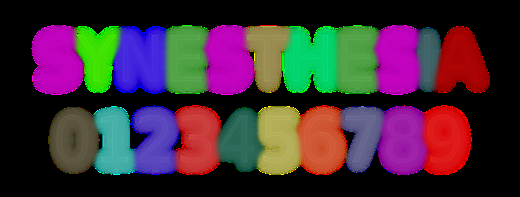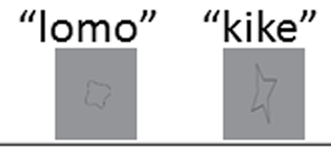Sensory connections spill over in synesthesia

Neuroscientists at Emory University have found that people who experience a mixing of the senses, known as synesthesia, are more sensitive to associations everyone has between the sounds of words and visual shapes. The results are published in the European Journal of Neuroscience.
Synesthesia is a stable trait, and estimated to be present in 1 to 4 percent of people. It can be inherited, although the precise genes have not been identified. One of the most common forms of synesthesia is when people involuntarily see particular colors in connection with letters, numbers or sounds.
Many artists and composers have described their experiences with synesthesia. Children with synesthesia say sometimes that it is distracting when they are trying to read. Thus, understanding the origins of synesthesia may help people with dyslexia or other learning differences, or people who have lost their sight or hearing and are trying to engage in sensory substitution for rehabilitation.
Researchers led by neurologist Krish Sathian, MD, PhD, recruited 17 people with synesthesia, and asked them to take a form of the IAT (implicit association test). Known for its use probing social attitudes such as racial prejudice, the IAT can also assess "cross-modal correspondences."
An example of a cross-modal correspondence is that we describe musical notes as being "high" or "low" – words that also signify relative positions in space. Another is that we think of some sounds such as "m" and "l" as soft, and are more likely to associate them with rounded shapes. Similarly, we connect hard sounds such as "k" and "t" with angular shapes.
"There's been a debate about synesthesia," Sathian says. "Are the associations synesthetes have just extreme versions of cross-modal correspondences that other people have, or are they qualitatively different?"
Sathian and his colleagues found that people with synesthesia were more sensitive to correspondences between the sounds of pseudowords—words without meaning in English—and rounded or angular shapes (see figure).

"It shows that something about their synesthesia is spilling over into another domain," he says. "But that spillover is limited to a correspondence that is post-perceptual and symbolic – it's not purely sensory."
Such correspondences are called "sound-symbolic," and may be relevant to the evolutionary orign of language, Sathian adds.
People with synesthesia were not significantly more sensitive to purely sensory associations between the pitch of a sound and the size or position of a shape, compared to non-synesthetes. In this situation, sensitivity on the IAT means that study participants would have a greater difference in response times to congruent pairings of shape and sound (a high position in space, and a high pitch, for example) in comparison to incongruent pairings.
Participants in the study were recruited through advertisements on the Emory campus and screened with an online test called the Synesthesia Battery. This test confirms whether people who report they have synesthesia have consistent associations.
A connection between letters or other symbols and colors, also known as "grapheme-color" synesthesia, was the most common type in the Emory study. It may represent the presence of idiosyncratic wrinkles in how people learned their letters or other symbols during childhood. Indeed, Sathian notes that one study suggests that a popular brand of refrigerator magnets had an influence on what letter-color associations people with this form of synesthesia developed.
To be sure, people with synesthesia are not all the same, says senior research associate Simon Lacey, PhD, the first author of the paper. Some describe experiencing connections between shapes and tastes, or porous boundaries between self and non-self (so-called "mirror touch")."
Brain imaging studies have shown that people with synesthesia tend to be wired differently: they display hyperconnectivity between parts of their brains related to their synesthetic experiences. Scientists have proposed that synesthesia represents alterations in pruning, the process of editing connections between brain cells.
More information: Simon Lacey et al. Synesthesia strengthens sound-symbolic cross-modal correspondences, European Journal of Neuroscience (2016). DOI: 10.1111/ejn.13381
Nathan Witthoft et al. Prevalence of Learned Grapheme-Color Pairings in a Large Online Sample of Synesthetes, PLOS ONE (2015). DOI: 10.1371/journal.pone.0118996
















